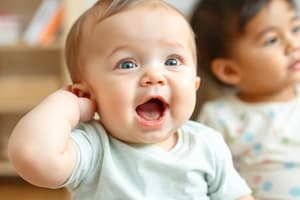Podcast
Questions and Answers
What is a primary reason for differences in research findings on sound mastery age?
What is a primary reason for differences in research findings on sound mastery age?
- Variations in the frequency of phonological processes
- The focus on vowel development over consonants
- Differences in the criteria for defining when a sound is acquired (correct)
- Inconsistencies in child language exposure
How do narratives and conversations primarily differ?
How do narratives and conversations primarily differ?
- Narratives often rely on visual aids, while conversations do not.
- Narratives are usually shorter than conversations.
- Narratives involve more listener participation than conversations.
- Conversations typically consist of turn-taking, unlike narratives. (correct)
Which conjunction do preschool children most commonly use when forming compound sentences?
Which conjunction do preschool children most commonly use when forming compound sentences?
- Or
- Because
- And (correct)
- But
Why are preschool children's definitions often said to be 'context bound'?
Why are preschool children's definitions often said to be 'context bound'?
What role do social interactions play in the development of Theory of Mind (ToM)?
What role do social interactions play in the development of Theory of Mind (ToM)?
What characteristic of narratives distinguishes them from other forms of communication?
What characteristic of narratives distinguishes them from other forms of communication?
What type of feedback do children receive less of during narrative construction compared to conversation?
What type of feedback do children receive less of during narrative construction compared to conversation?
What is a common misconception about the development of sound mastery in children?
What is a common misconception about the development of sound mastery in children?
What foundational skill is critical for the development of Theory of Mind in infants?
What foundational skill is critical for the development of Theory of Mind in infants?
Which of the following sentences best represents a complex sentence structure?
Which of the following sentences best represents a complex sentence structure?
What is a key feature of narratives that distinguishes them as decontextualized language forms?
What is a key feature of narratives that distinguishes them as decontextualized language forms?
Identify the example of a contractible auxiliary.
Identify the example of a contractible auxiliary.
Which phonemes are considered to develop latest in children?
Which phonemes are considered to develop latest in children?
Which pronouns are generally the first to be acquired by children?
Which pronouns are generally the first to be acquired by children?
Which example illustrates a preschooler using physical characteristics to describe an object?
Which example illustrates a preschooler using physical characteristics to describe an object?
Which type of sentence typically lacks complexity?
Which type of sentence typically lacks complexity?
Which of the following is an example of an early-developing sound in language acquisition?
Which of the following is an example of an early-developing sound in language acquisition?
What type of 'Wh' question is typically mastered first during language development?
What type of 'Wh' question is typically mastered first during language development?
Which of the following properties is shared by both oral narration and written text?
Which of the following properties is shared by both oral narration and written text?
How do contextualized and decontextualized language differ?
How do contextualized and decontextualized language differ?
What is one benefit of parental storybook reading for preschoolers?
What is one benefit of parental storybook reading for preschoolers?
Which of the following best characterizes decontextualized language?
Which of the following best characterizes decontextualized language?
What is a primary characteristic of both oral narration and written text?
What is a primary characteristic of both oral narration and written text?
Which of the following statements is true regarding the development of language skills in children?
Which of the following statements is true regarding the development of language skills in children?
What is the significance of grammatical morphemes in language development?
What is the significance of grammatical morphemes in language development?
Why are basic concepts essential for children?
Why are basic concepts essential for children?
What skill related to word relationships do preschoolers begin to develop?
What skill related to word relationships do preschoolers begin to develop?
Which narrative development stage is characterized by labels and descriptions of events with no central theme?
Which narrative development stage is characterized by labels and descriptions of events with no central theme?
What term describes a child's mental dictionary that increases in size during the preschool years?
What term describes a child's mental dictionary that increases in size during the preschool years?
Which of the following best describes decontextualized language?
Which of the following best describes decontextualized language?
What is an important characteristic of focused chains in narrative development?
What is an important characteristic of focused chains in narrative development?
At what stage do children typically start to categorize items and identify their relationships?
At what stage do children typically start to categorize items and identify their relationships?
Flashcards
Sound Mastery Discrepancies
Sound Mastery Discrepancies
Differences in how researchers define when a child has mastered all the sounds of a language. This can lead to inconsistencies in research about the age of sound mastery.
Narrative vs. Conversation
Narrative vs. Conversation
A narrative is a monologue where a speaker tells a story or provides information, while a conversation involves turn-taking between speakers.
First Conjunction
First Conjunction
The conjunction 'and' is typically the first one preschoolers use when forming compound sentences.
Context-Bound Definitions
Context-Bound Definitions
Signup and view all the flashcards
Social Interactions for ToM
Social Interactions for ToM
Signup and view all the flashcards
Early-Developing Sounds
Early-Developing Sounds
Signup and view all the flashcards
Mastered "Wh" Question
Mastered "Wh" Question
Signup and view all the flashcards
Oral Narration vs. Written Text
Oral Narration vs. Written Text
Signup and view all the flashcards
Contextualized Language
Contextualized Language
Signup and view all the flashcards
Decontextualized Language
Decontextualized Language
Signup and view all the flashcards
Parental Storybook Reading
Parental Storybook Reading
Signup and view all the flashcards
Semantic Development
Semantic Development
Signup and view all the flashcards
Grammatical Morphemes
Grammatical Morphemes
Signup and view all the flashcards
Basic Concepts
Basic Concepts
Signup and view all the flashcards
Word Relationships
Word Relationships
Signup and view all the flashcards
Heaps
Heaps
Signup and view all the flashcards
Lexicon
Lexicon
Signup and view all the flashcards
Mental States
Mental States
Signup and view all the flashcards
Narrative Development
Narrative Development
Signup and view all the flashcards
Joint Attention
Joint Attention
Signup and view all the flashcards
Complex Sentence
Complex Sentence
Signup and view all the flashcards
Contractible Auxiliary
Contractible Auxiliary
Signup and view all the flashcards
Latest Developing Phonemes
Latest Developing Phonemes
Signup and view all the flashcards
First Pronouns
First Pronouns
Signup and view all the flashcards
Perceptual Characteristics
Perceptual Characteristics
Signup and view all the flashcards
Narrative Distancing
Narrative Distancing
Signup and view all the flashcards
Study Notes
Theory of Mind (ToM) in Infants
- Key foundational skill for ToM emergence in infancy is joint attention with caregivers
Complex Sentence Example
- Example of a complex sentence: "I told Sally who told Mommy."
Decontextualized Language in Narratives
- Key feature of narratives that makes them decontextualized language forms is requiring distancing from immediate experience to discuss past or imaginary events
Contractible Auxiliary
- Example of a contractible auxiliary: "Mommy's working"
Latest Developing Phonemes
- The latest developing phonemes are "m," "n," "p," and "b."
Earliest Developing Pronouns
- The first pronouns to develop in children are "I" and "mine."
Preschooler's Perceptual Descriptions
- Example of a preschooler describing an item based on perceptual characteristics: "A hammer is used to build things."
Discrepancies in Sound Mastery Research
- Factors contributing to discrepancies in research on the age of sound mastery include: differences in criteria for defining when a sound is acquired and inconsistencies in child language exposure.
Narrative vs. Conversation
- Narratives are different from conversations because narratives involve a monologue where the speaker provides all the information, while conversations involve turn-taking.
Conjunctions in Compound Sentences
- Preschoolers typically use "and" first when constructing compound sentences.
Preschool Definitions and Context
- Preschool definitions are considered "context-bound" due to their heavy reliance on a child's current experiences and surroundings.
Social Interactions and ToM Development
- Social interactions are critical for ToM development because they allow children to practice understanding and predicting others' mental states.
Grammatical Morphemes in Language Dev.
- Grammatical morphemes provide grammatical detail and structure to sentences.
Importance of Basic Concepts
- Basic concepts are critical for children to follow directions and participate in classroom routines.
Word Relationship Skills in Preschoolers
- Preschoolers begin to develop the skill of categorizing items and identifying how they "fit together."
Primitive Narrative Stage
- The primitive narrative stage is characterized by labels and descriptions of events or actions with no central theme or organization.
Child's Mental Dictionary
- The term for a child's rapidly growing mental dictionary during preschool years is "lexicon."
Example of Decontextualized Language
- Example of decontextualized language: "My mom baked a chocolate cake yesterday."
Early Developing Sounds
- Early developing sounds include "m," "p," "b," and "w."
"Wh" Question Mastery
- The earliest "wh" question types mastered during language development are where questions.
Shared Properties of Oral and Written Narratives
- A shared property between oral narration and written text is the use of concise and complex syntax.
Contrasting Contextualized and Decontextualized Language
- Contextualized language is used in immediate surroundings, while decontextualized language describes events beyond the "here and now."
Parental Storybook Reading and Semantic Development
- Parental storybook reading enhances vocabulary growth in preschoolers.
Age of "Adult Standard Speech"
- Researchers generally agree that children achieve "adult standard speech" between ages 7 and 8.
Studying That Suits You
Use AI to generate personalized quizzes and flashcards to suit your learning preferences.




